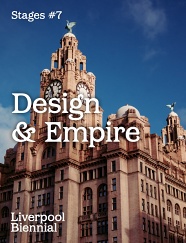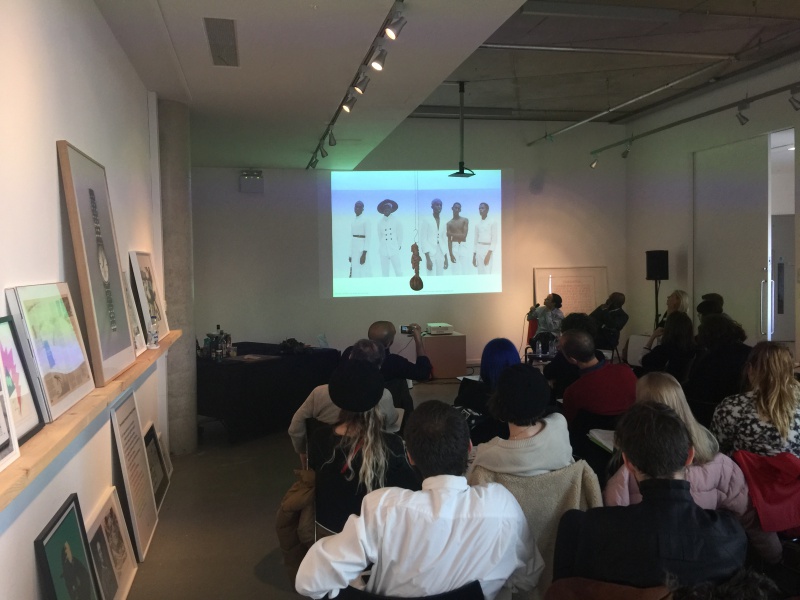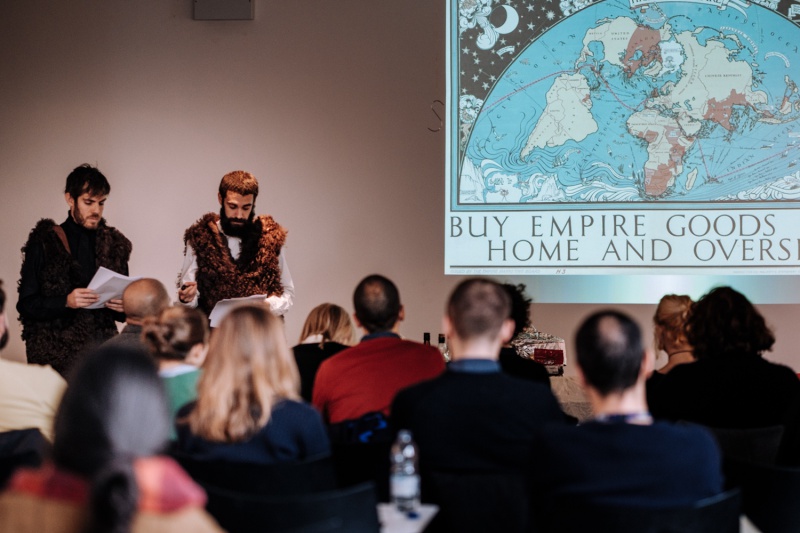
Notes on Design & Empire
Joasia Krysa

Graphic identity for Design & Empire [working title] using the typeface ‘media police’ by Société Réaliste, 2017. Courtesy Wkshps, New York.
Graphic identity for Design & Empire [working title] using the typeface ‘media police’ by Société Réaliste, 2017. Courtesy Wkshps, New York.
"Empire is materialising before our very eyes."
(Hardt & Negri,
Empire, 2000)
Liverpool established its international reputation as a pre-eminent gateway for shipping, trade and the movement of people in multiple, sometimes troubling, ways. The city created to service this exchange – dense in buildings, public spaces and infrastructure, financed with colonial profits – became a major port of the British Empire. Today, Liverpool presents an even more complex story, having undergone serious decline since the industrial period, followed by intense regeneration when it became European Capital of Culture in 1998, and now part of the ‘Northern Powerhouse’.
Set against this backdrop, with Liverpool as both subject and stage, the Design & Empire [working title] symposium challenged some of the aspects of Liverpool’s imperial legacy whilst reflecting on wider current practices within design and visual culture. How does one reflect the other? How does Empire materialise in contemporarycultural practices? How can we discuss this without becoming part of the problem?
Michael Hardt and Antonio Negri’s seminal book Empire seems to provide some clues. To the authors, Empire is a 'decentered and deterritorializing apparatus of rule that progressively incorporates the entire global realm within its open, expanding frontiers. Empire manages hybrid identities, flexible hierarchies, and plural exchanges through modulating networks of command.’[1]
Today’s Empire, then, as opposed to previous imperialist forms, develops out of changed (and changing) economic and cultural exchanges. Rather than working through nation-states, Empire takes new networked forms and requires no fixed or territorial centre of power. No nation state, not even the USA, holds such a pivotal position today as was maintained by the Roman or the British Empires, for example, and Brexit can be explained as a symptom of this perceived impotence. In this new world order, the periphery and centre are thoroughly embedded in each other. Any major city provides evidence of this, not least Liverpool.
Conceived by curators Emily King and Prem Krishnamurthy, and presented by Liverpool Biennial and Liverpool John Moores University’s School of Art and Design over three days in November 2017, Design & Empire [working title] brought together leading creative voices from the fields of art, design, architecture and fashion to discuss some of these paradoxes of power. Framed by guided city tours exploring Liverpool’s architectural past, and the cooking and serving of a colonial-style Christmas Pudding, it featured conversations on topics ranging from national identity to the display of museum collections, postcolonial approaches to contemporary fashion, copying within creative manufacturing, the reuse and revaluation of bio-industrial materials, and the politics of computer interfaces in relation to the new networked forms of empire.

Image from Empire Talks IV by Grace Wales Bonner & Duro Olowu, Design & Empire, Liverpool John Moores University’s Exhibition Research Lab, November 2017.
This volume of Stages presents a partial record of these conversations, some related projects and other responses from a selection of participants: Cooking Sections, Christian Ulrik Andersen, Frederico Duarte, Paul Elliman, Emily King, Prem Krishnamurthy, Mae-ling Lokko and Christopher Kulendra Thomas.
Taking their cue from the phrase ‘every event is a rehearsal for the next event’, the curators Emily King and Prem Krishnamurthy reflect on the event in their text Learning from Liverpool: An Introduction. Following the Liverpool event, they asked participants for their comments, as well as new texts or objects, which they used as working material several months later, in March 2018, held at K, in Schöneberg, Berlin. In their words, ‘these contributions, ranging from graphic ephemera to magazine spreads and an immersive video, made visible the conversations that emerged during the symposium’ and provided the basis for further thinking and for their contribution to this volume.
Empire Remains Christmas Pudding by artist duo Cooking Sections (Daniel Fernández Pascual & Alon Schwabe), explored the systems that organise the world through food. Much like their hybrid performance lecture and food event Stir-up Sunday presented in Liverpool, their short text for this volume operates between visual art, architecture and geopolitics. ‘Stir-up Sunday’ is the last Sunday before Advent. The name comes from the Book of Common Prayer’s collect for the day (‘Stir up, webeseech thee, O Lord, the wills of thy faithful people’), but it is nowmore associated with the custom of making a Christmas Pudding, a dishwith ingredients that were once sourced across the British Empire. Cooking Sections’ contribution introduced the myriad web of colonial routes and locations thatunderlie contemporary culinary fare, taking the pudding as both a case study and object for consumption.

Image of Stir-up Sunday session by Cooking Sections, Design & Empire, Liverpool John Moores University’s Exhibition Research Lab, November 2017. Photo: Jay Chow
Paul Elliman takes a similar approach in his text – an idiosyncratic mixture of dense historical and poetic, visual and literary ingredients. But rather than food, his essay Contents of Ostrich’s Stomach focuses on the links, both historical and metaphorical, between the mistreatment of animals and colonialism. Moving from an image of the contents of an ostrich’s stomach at London Zoo through observations on historic royal menageries to reflections on the writings of Kipling, Orwell and Lawrence, he ends with an analysis of the interplay between language and power.
Architectural historian and material technologist Mae-ling Lokko presents a new visual essay Brown is the New Green, drawing attention to Africa’s agriculture as both ‘the bloodline for Africa’s growth, as well as its looting’. Derived from her visits to coconut-farming operations in 2014 and 2015, her essay casts light on Ghana’s diverse farming and manufacturing industry around the coconut and its husk, a resilient material with a vast number of applications. She argues that thisrecent awakening of large parts of the continent to the potential for activating profits from the agro-upcycling economy can serve as an engine for positive development.
Writer and curator Frederico Duarte has recently staged an exhibition of contemporary Brazilian design, How to Pronounce Design in Portuguese: Brazil Today at Lisbon’s MUDE –Museum of Design and Fashion. His text for this volume, Designing Brazil Today, an edited version of an essay first written for the catalogue (published by MUDE, Francisco Capelo Collection, June 2018), takes the exhibition as a case study to discuss the intersections between design and national identity, making reference to the collecting policies of a museum that was once at the heart of imperialism.
In the context of digital design and software studies, Christian Ulrik Andersen explores the politics of the computer interface with reference to the Scandinavian tradition of critical interface design and the labour movement. The essay for this volume, UTOPIA and the Metainterface – Participatory Interface Design from the Print Press to Today, draws attention to wider digital infrastructures and new technological paradigms that appear to be replacing the old global order of nation-state empires.
Christopher Kulendran Thomas, New Eelam, screenshot of website www.new-eelam.com, accessed 15/07/2018.
Finally, Christopher Kulendran Thomas’s project New Eelam proposes a provocative model of distributed citizenship in the form of a tech start-up, to examine how the rethinking of interfaces, residences and networked systems offers opportunities for new structures to emerge. Presented at the symposium in Liverpool in the form of a sales pitch, the project is featured on this volume’s contents page as a series of advertising images.
That this journal is a partial account of an event that in itself was a prototype for another possible event materialises the contingent nature of empire and design. Both fields are ripe for reinvention.
[1] Michael Hardt and Antonio Negri, Empire (Cambridge, MA: Harvard University Press, 2000), p. 12-13.
Download this article as PDF
Joasia Krysa
Joasia Krysa is Professor of Exhibition Research and Director of Exhibition Research Lab at Liverpool John Moores University, with a joint appointment at Liverpool Biennial. Formerly she served as Artistic Director of Kunsthal Aarhus, Denmark, part of curatorial team for dOCUMENTA 13 (Kassel 2012), and co-curator of Liverpool Biennial 2016. Her recent publications include Systemics, or Exhibition as a Series (Sternberg Press 2017) and Writing and Unwriting Media Art History (MIT Press 2015). She is series editor of DATA Browser (Open Humanities Press) and commissioning editor of contemporary art journal Stages published by Liverpool Biennial.
- Notes on Design & Empire
Joasia Krysa - Learning from Liverpool: An Introduction
Emily King and Prem Krishnamurthy - Empire Remains Christmas Pudding
Cooking Sections - Contents of Ostrich’s Stomach
Paul Elliman - Brown is the New Green
Mae-ling Lokko - Designing Brazil Today
Frederico Duarte - UTOPIA and the Metainterface
Christian Ulrik Andersen - Colophon


